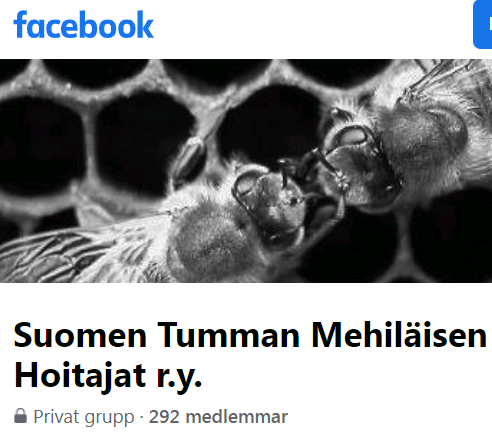SICAMM conference 2018
The SICAMM conference 2018 was organised at Mustiala agricultural school, southern Finland by the Finnish Beekeepers’ Association between July 12 and July 15, 2018.
There were as much as 90 participants at the conference. The attendees saw 32 presentations on topics as diverse as country reports on preservation of Apis mellifera mellifera, DNA analyses of the species, bee breeding, varroa tolerance and branding of the honey produced by dark bees.
At the official SICAMM meeting, Marlean Boerjan from the Netherlands was elected as a new President of this international society.
The programme of the conference, conference abstracts as well as the presentations made publicly available by the speakers can be viewed below:
Friday 13th July 2018
9:00 Opening ceremony
10:00 Keynote speaker Bjørn Dahle, Norway: SMARTBEES – Sustainable mangament of resilient bee populations
10:45 Coffee break
11:05 Per Thunman: SICAMM today and tomorrow
11:25 Lassi Kauko: Dark bees in Finland
11:45 Lars Kirkerud: Brown bees in A. m. mellifera in Norway – present situtation
12:05 Joseph Widdecombe: Bee farming with the native bee in Cornwall
12:25 Ralf Ulrich: Dark bees in Germany
12:45 Annika Michelson: Dark bees in Estonia
13:05 Lunch
14:00 Maritta Martikkala: Beekeeping in Finland
14:20 Beata Panasiuk: Conservation programs of Apis mellifera mellifera bees in Poland
14:40 Łucja Sconieczna: Variability of morphplogical features of the native middle-European bee
15:00 Dylan Elen: The dark bee movement in North-Belgium – an update
15:20 Coffee break
16:00 Melanie Parejo: Honeybee conservation genomics in Switzerland and informative SNPs to estimating C-lineage introgression in A. m. mellifera
16:20 Norman Carreck: Where are we heading with local bees in Britain and Ireland?
18:00 Smoke sauna and social event at Korteniemi traditional farm
Saturday 14th July 2018
9:00 Keynote speaker Ralph Büchler, Germany: Honey bee mating behavior drives selection on local adaptation and disease resistance
9:45 Dorian Pritchard: Geordie bees bite the mite
10:20 Coffee break
10:40 Roger Patterson: Sustainability – can we all work together?
11:20 Małgorzata Bieńkowska: Bee breeding activity in Poland
11:40 Lauri Ruottinen: Mustiala – history and education
12:00 Risto Kuittinen: How a measuring system can help the management of honey bee colonies
12:20 Aimo Nurminen: Branding the honey of dark bees
12:40 Nils Jacob Drivdal: Diversity – a challenge for dark bee projects
13:00 Lunch
14:00 Alice Pinto: A novel SNP-based tool for estimating C-lineage introgression in the dark honey bee
14:20 Ingvar Arvidsson: Dark bees in Sweden
14:40 Marleen Boerjan: Natural selection of varroa tolerant Apis mellifera mellifera ‘black bee’ colonies in the Netherlands
15:00 Dylan Elen: Breeding for conservation – a new European initiative
15:20 Coffee break
16:10 Jack Hassett: Significant pure population of the dark European honey bee (Apis mellifera mellifera) remains in Ireland
16:30 Helen Mooney: Investigations into wild black bees in Ireland
18:00 Dinner with a historical theme
Sunday 15th July 2018
9:00 Keynote speaker Per Kryger, Denmark: Bee races in Europe, their genetic characteristics and relationships
9:45 Padruot Fried: Results and conclusions of the project to protect the Dark Bee in Switzerland, 2015-17
10:05 Jonathan Ellis: Introgression in native populations of Apis mellifera mellifera L in the UK: implications for conservation
10:30 Coffee break
10:50 Jacques van Alphen: Is natural selection alone enough for the evolution of resistance against varroa in the European honeybee?
11:10 Anneli Salonen: Are there differences in honey collected by Italian and dark honey bees?
11:30 Jussi Marin: Goal, it´s honey!
11:50 Helen Mooney: SICAMM 2020 congress in Ireland
12:10 SICAMM meeting
13:00 Lunch
Transport to Turku area for excursion participants and possibly a shuttle bus to the airport.
Monday 16th July
Excursion: Dark bee breeding magic in the sunny archipelago
Let´s take a look at a bee breeding station in the sunny archipelago! Pakinainen has had a pure breeding operation of the dark bee since year 2000. No other honey bee races are thus kept here. The location of the island is shown here: Pakinainen map. Pakinainen is the largest island in western Rymättylä, a municipality which is nowadays a part of Naantali city. The island is home to a couple of families around the year and in the summertime, the beautiful Rymättylä archipelago attracts summer cottage owners and other holiday seekers. In addition to the bees, we will take a look at the rich flora of the island.
Tuesday 17th July
Excursion: Presidential bees and flowers, Naantali old town and something sparkling
The main attraction is the Kultaranta Garden in Naantali. Kultaranta Manor House was built in 1916 and it has been the summer residence of Finnish presidents since 1922. The 54-hectare estate has a market garden and a formal garden with e.g. thousands of roses of several different varieties (some of them named after former presidents, such as Rosa ´Tarja Halonen´). Honey bees have been around in the garden for about 30 years and dark bees have been kept here for 10+ years. Our second attraction is Naantali Old Town, dating back to the 15th century. We will also visit the Naantali Abbey, which was a Bridgettine abbey in then-Swedish Finland. Our last stop will be the Brinkhall Sparkling Factory & Shop in Rymättylä: https://www.bsp.fi/.
Wednesday 18th July
Open house visit at the major Finnish honey processor Hunajayhtymä Ltd., one of the Conference sponsors. More information about the company: http://www.hunaja.fi/en/

